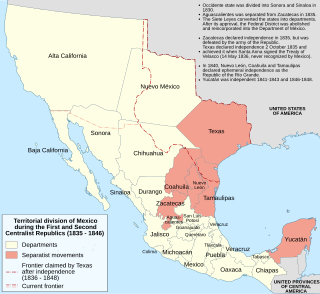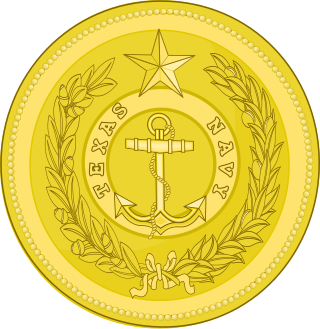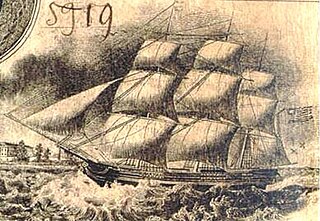
The Battle of San Jacinto, fought on April 21, 1836, in present-day La Porte and Deer Park, Texas, was the final and decisive battle of the Texas Revolution. Led by General Samuel Houston, the Texan Army engaged and defeated General Antonio López de Santa Anna's Mexican army in a fight that lasted just 18 minutes. A detailed, first-hand account of the battle was written by General Houston from the headquarters of the Texan Army in San Jacinto on April 25, 1836. Numerous secondary analyses and interpretations have followed.

Captain Jeremiah O'Brien (1744–1818) was an American captain in the Massachusetts State Navy. Prior to its existence, he commanded the sloop Unity when he captured the British armed schooner HMS Margaretta in the Battle of Machias, the first naval battle of the American Revolutionary War. He also led the first American attack on Nova Scotia in the Raid on St. John (1775). Six United States ships were named in his honor.
The "Battle of Tampico" was fought November 15, 1835, in the Mexican state of Tamaulipas. Gregorio Gómez and the Mexican Centralist garrison engaged Gen. José Antonio Mexía and 150 American volunteers. This was part of an uprising against General Santa Anna, and its outcome affected the future of the Texas War of Independence.

The Runaway Scrape events took place mainly between September 1835 and April 1836 and were the evacuations by Texas residents fleeing the Mexican Army of Operations during the Texas Revolution, from the Battle of the Alamo through the decisive Battle of San Jacinto. The ad interim government of the new Republic of Texas and much of the civilian population fled eastward ahead of the Mexican forces. The conflict arose after Antonio López de Santa Anna abrogated the 1824 Constitution of Mexico and established martial law in Coahuila y Tejas. The Texians resisted and declared their independence. It was Sam Houston's responsibility, as the appointed commander-in-chief of the Provisional Army of Texas, to recruit and train a military force to defend the population against troops led by Santa Anna.
This is a timeline of the Republic of Texas, spanning the time from the Texas Declaration of Independence from Mexico on March 2, 1836, up to the transfer of power to the State of Texas on February 19, 1846.

The Texas Navy, officially the Navy of the Republic of Texas, also known as the Second Texas Navy, was the naval warfare branch of the Texas Military Forces during the Republic of Texas. It descended from the Texian Navy, which was established in November 1835 to fight for independence from Centralist Republic of Mexico in the Texas Revolution. The Texas Navy, Texas Army, and Texas Militia were officially established on September 5, 1836 in Article II of the Constitution of the Republic of Texas. The Texas Navy and Texas Army were merged with the United States Armed Forces on February 19, 1846 after the Republic of Texas became the 28th state of the United States.

The Texan schooner Brutus was one of the four ships of the First Texas Navy (1836–1838) that during the Texas Revolution wreaked havoc on towns along the coast of Mexico, blockaded Mexican ports, and captured ships bound for Mexico with goods and munitions of war.
The Texas schooner Invincible was one of the four schooners of the Revolutionary Texas Navy (1836-1837). She began her service in January 1836 and immediately began attacking ships supplying the Mexican army in Texas, including capturing the United States merchant vessel Pocket and later the British ship Eliza Russell. Both of these actions caused diplomatic incidents between the Republic of Texas and the United States and the United Kingdom.

The Texas schooner Liberty was one of the four schooners of the First Texas Navy (1836–1838). She served in the Texas Navy for only about 6 months, capturing the Mexican brig Pelicano loaded with weapons for their army in Texas. Later that year, she sailed to New Orleans accompanying the wounded Sam Houston, where she was repaired. Texas was unable to pay for the repairs and the ship was sold in June, 1836, to pay for the cost of the repairs. This left the Texas Navy with only three ships.

The Texan brig Wharton was a two-masted brig of the Second Texas Navy from 1839 to 1846. She was the sister ship of the Archer. Accompanying the Texas flagship, Austin, she defeated a larger force of Mexican Navy steamships in the Naval Battle of Campeche in May 1843. Transferred to the United States Navy in 1846, she was sold for $55.

The Texan sloop-of-war Austin was the flagship of the Second Texas Navy from 1840 to 1846. Commanded by Commodore Edwin Ward Moore, she led a flotilla in the capture of Villahermosa in 1840. After a period of inaction in port, Austin participated in the Naval Battle of Campeche in 1843. Austin was transferred to the United States Navy when Texas joined the United States in 1845, but was run aground and broken up in 1848.

The Texan schooner San Jacinto was a two-masted schooner of the Second Texas Navy from 1839 to 1840. She was the sister ship of the San Antonio and the San Bernard. In 1840, San Jacinto was part of the Texas Navy flotilla led by Commodore Edwin Ward Moore which was dispatched to assist Yucatecan rebels that had taken up arms against Mexico. In a storm, San Jacinto ran aground at Cayos Arcas and was wrecked. The crew were rescued by the flagship Austin.

The Texan schooner San Antonio was a two-masted schooner of the Second Texas Navy from 1839-1840. She was the sister ship of the San Jacinto and the San Bernard. In 1840, San Antonio was part of the Texas Navy flotilla led by Commodore Edwin Ward Moore which was dispatched to assist Yucatecan rebels that had taken up arms against Mexico. In February 1842, while re-provisioning in New Orleans, the crew of the San Antonio mutinied and the Lieutenant was killed. This was the only mutiny in the history of the Texas Navy. That fall, the San Antonio sailed for Campeche and was never heard from again.

The Texan schooner San Bernard was a two-masted schooner of the Second Texas Navy from 1839-1840. She was the sister ship of the San Jacinto and the San Antonio. In 1840, San Antonio was part of the Texas Navy flotilla led by Commodore Edwin Ward Moore which was dispatched to assist Yucatecan rebels that had taken up arms against Mexico. Returning to the Yucatan in 1841, San Bernard assisted in the capture of three Mexican prizes. Upon return to Galveston, San Bernard was driven ashore and was not repaired. When Texas joined the United States in 1846, San Bernard was transferred to the United States Navy and then sold for $150.

The Texian Army, also known as the Revolutionary Army and Army of the People, was the land warfare branch of the Texian armed forces during the Texas Revolution. It spontaneously formed from the Texian Militia in October 1835 following the Battle of Gonzales. Along with the Texian Navy, it helped the Republic of Texas win independence from the Centralist Republic of Mexico on May 14, 1836 at the Treaties of Velasco. Although the Texas Army was officially established by the Consultation of the Republic of Texas on November 13, 1835, it did not replace the Texian Army until after the Battle of San Jacinto.

The Battle of the Brazos River was an engagement fought in the Brazos River on April 17, 1837, between the Mexican Navy and the Texian Navy.

The Callao affair occurred in November 1820, during the Peruvian War of Independence. It began when a Spanish fort opened fire on the United States warship USS Macedonian. Though the ship was damaged, the Americans did not violate their neutrality by counterattacking. On the following day, a boat filled with United States Navy sailors was attacked, resulting in the deaths of two seamen and the wounding of eight others. Two days after that, an American merchant ship was attacked and her crew had to abandon ship. Ultimately, there was no significant response by the United States to the attacks on their shipping and their citizens, though the Spanish government vowed to punish the perpetrators.

The Ingham Incident, or the Montezuma Affair, was a naval battle fought in 1835, the first between Mexico and the United States. The Mexican warship Montezuma patrolled the coast of Texas to prevent the smuggling of contraband into the territory. During the cruise, the Mexicans captured the American merchant ship Martha and later the Texan ship Columbia which led to a response by the United States Revenue-Marine revenue cutter USRC Ingham. A bloodless engagement was fought on June 14, and ended when the Montezuma was purposely run aground to prevent capture.

The Texian Navy, also known as the Revolutionary Navy and First Texas Navy, was the naval warfare branch of the Texian armed forces during the Texas Revolution. It was established by the Consultation of the Republic of Texas on November 25, 1835. Along with the Texian Army, it helped the Republic of Texas win independence from the Centralist Republic of Mexico on May 14, 1836 at the Treaties of Velasco. It was replaced by the Texas Navy on March 23, 1839.












